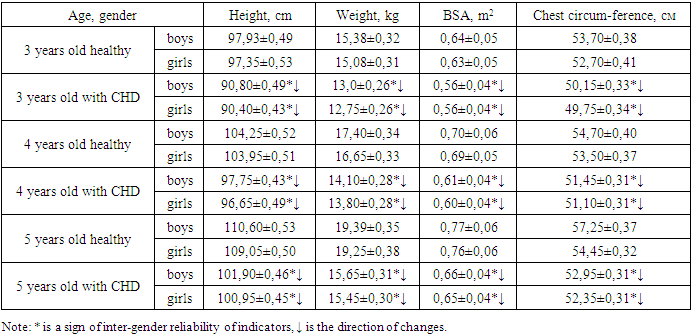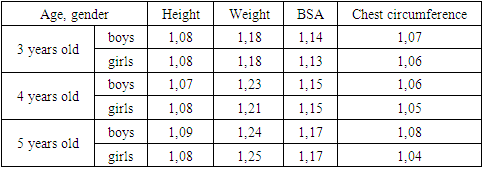-
Paper Information
- Next Paper
- Previous Paper
- Paper Submission
-
Journal Information
- About This Journal
- Editorial Board
- Current Issue
- Archive
- Author Guidelines
- Contact Us
American Journal of Medicine and Medical Sciences
p-ISSN: 2165-901X e-ISSN: 2165-9036
2023; 13(11): 1794-1797
doi:10.5923/j.ajmms.20231311.40
Received: Nov. 6, 2023; Accepted: Nov. 23, 2023; Published: Nov. 25, 2023

Comparative Parameters of Height and Weight Measurements in Healthy and Children with Congenital Heart Diseases 3-10 Years Old
N. K. Khamidova , R. R. Baymuradov
Bukhara State Medical Institute, Bukhara, Uzbekistan
Copyright © 2023 The Author(s). Published by Scientific & Academic Publishing.
This work is licensed under the Creative Commons Attribution International License (CC BY).
http://creativecommons.org/licenses/by/4.0/

Anthropometry is a generally accepted method for assessing a child's growth and development. The main anthropometric parameters that determine the physical development of children and adolescents are weight, height, chest circumference and body surface area. The purpose of the study was to study the parameters of physical development of healthy children and children with congenital heart diseases aged 3-10 years. Materials and methods. 400 healthy children from 3 to 10 years old were studied, of which 200 were girls and 200 were boys. In conclusion, we state that in healthy and sick 6-year-old boys and girls with congenital heart diseases, similar parameters were obtained with children 3-5 years old, where the trend and intensity of changes were the same, and in sick children 6 years old, the main anthropometric parameters (height, weight, BSA and chest circumference) were significantly reduced in relation to the data of healthy children of the same age, and this applied to both sexes studied.
Keywords: Anthropometry, Children, Chest circumference
Cite this paper: N. K. Khamidova , R. R. Baymuradov , Comparative Parameters of Height and Weight Measurements in Healthy and Children with Congenital Heart Diseases 3-10 Years Old, American Journal of Medicine and Medical Sciences, Vol. 13 No. 11, 2023, pp. 1794-1797. doi: 10.5923/j.ajmms.20231311.40.
1. Introduction
- The growth of various body parameters is an important indicator for assessing the health of children [1]. Children's development can be assessed through a life history, physical examination, and anthropometric measurements. Anthropometry is a generally accepted method that can be used for younger generations [5]. In children, measurements reflect general health, nutritional adequacy, and growth and development over time [3]. Also, these parameters are a mirror of the social and economic well-being of the country [4].Anthropometric parameters are interpreted by comparison with reference data for age and sex. Interpretation of an individual child's anthropometric measurements will depend on the reference data used. Clinicians are often faced with a dilemma when choosing a height reference for anthropometric assessment among various national and international growth standards [5]. Therefore, the standards set by the World Health Organization are used and accepted in at least 125 countries [2,6]. The main anthropometric parameters that determine the physical development of children and adolescents are weight, height, chest circumference and body surface area. There is a lot of information in modern literature that provides these indicators separately, but it is difficult to find general information linking all these parameters together.Purpose of the study: to study the parameters of physical development of healthy children and children with congenital heart diseases aged 3-10 years old.
2. Materials and Methods
- 400 healthy children and children with congenital heart diseases from 3 to 10 years old were studied, of which 200 girls and 200 boys. The study involved children from secondary school No. 2 and preschool No. 51 in the city of Bukhara. Anthropometric parameters of sick children were measured in the private clinic “Nasriddin Shams”. Before conducting the research, consent was obtained from the parents of the children involved in the research.To study the morphofunctional state and characteristics of puberty in children aged 3-10 years, well-known methods of anthropometry and physiometry were chosen. Anthropometric measurements included determination of the following parameters: body weight (kg); height (cm); chest circumference (cm); body surface area (m2).Body length was measured by a medical stadiometer (with an accuracy of 0.5 cm); body weight - on medical scales (accurate to 50 g).A tape measure was used to measure chest circumference. The following formula was used to determine the body surface area:BSA = (weight (kg)0.425 * height (cm)0.725)/139.2All results were statistically processed and the degree of reliability of the indicators was determined.
3. Research Results
- The results obtained show that in sick 3-year-old boys with congenital heart diseases, the average height was 90.80±0.49 cm, which is 1.08 times significantly lower than the parameters of healthy children of the same age (P<0. 05) – table 1. Almost the same results were obtained in sick 3-year-old girls.
|
|
|
|
4. Conclusions
- Thus, the results obtained from a comparative analysis of the height and weight parameters of healthy and sick children with congenital heart diseases of both sexes show that all the studied parameters (height, weight, BSA and chest circumference) were significantly different from each other, and these differences were almost the same in both sexes. All average indicators of height, weight, BSA and chest circumference were significantly reduced in children with heart defects in relation to these data in healthy children. The greatest differences were observed in weight and BSA (P<0.05). It should be emphasized that there were no statistically significant differences between the indicators of sick boys and girls, which indicates that heart defects equally negatively affect the anthropometric indicators of both sexes.In healthy and sick 6-year-old boys and girls with congenital heart diseases, similar parameters were obtained with children 3-5 years old, where the trend and intensity of changes were the same, and in sick children 6 years old, the main anthropometric parameters (height, weight, BSA and chest circumference) were significantly reduced in relation to data from healthy children of the same age, and this applied to both sexes studied.The results obtained from studying the height and weight parameters of children aged 7-10 years old with congenital heart diseases showed that their height, weight, BSA and chest circumference were on average low in relation to the data of healthy children of the same age, and all indicators differed statistically significantly between itself (P<0.05). It must be emphasized that this applied to both boys and girls with congenital heart diseases. It follows from this that, firstly, congenital heart diseases have a negative impact on the physical development of children 7-10 years old, which is characterized by reduced parameters of height, weight, BSA and chest circumference, secondly, the decrease was observed equally in both sexes, and thirdly, the trend and the intensity of the decrease were similar to each other except for weight and BSA, which were slightly higher than other compared indicators.
 Abstract
Abstract Reference
Reference Full-Text PDF
Full-Text PDF Full-text HTML
Full-text HTML


